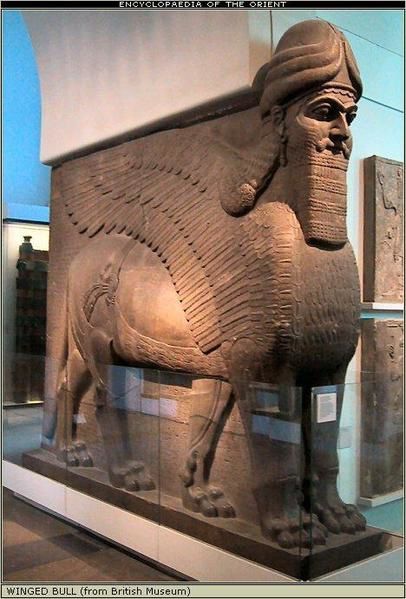Assyria
ASSYRIA – http://lexicorient.com/e.o/assyria.htm
Ancient country in the Middle East, with centre in modern Iraq along the Tigris river. At its height in the 7th century BCE, Assyria also covered areas in modern eastern Turkey, Syria, Lebanon, Palestine, Israel, western Iran, Kuwait and Egypt.
Society and Economy
Basic to the central region of Assyria was farming, fed by both the Tigris river and water from the Armenian mountains in the north, and the Zagros mountains in the east. With the expansion of Assyria, more land brought other economies, like mining and forestry.![]() It is believed that Assyria's civilization resulted from the immigration of an unknown people into the area around 6000 BCE. This was followed by Semitic immigration about 3 millenia later.
It is believed that Assyria's civilization resulted from the immigration of an unknown people into the area around 6000 BCE. This was followed by Semitic immigration about 3 millenia later.![]() Life was confined to small villages, and there was an intricate system of irrigation that fed the agriculture. There were few larger cities, and these served as trade and craft centres. Assyria had some slaves, but these played only a small part in the economy.
Life was confined to small villages, and there was an intricate system of irrigation that fed the agriculture. There were few larger cities, and these served as trade and craft centres. Assyria had some slaves, but these played only a small part in the economy.![]() The Assyrians were noted for their vast knowledge in warfare and organization.
The Assyrians were noted for their vast knowledge in warfare and organization.
Administration
Assyria had a traditional form of monarchy, in which the king answered only to his court. The king's son would normally take over as the new ruler at the old king's death. Local administration was organized around area rulers who paid taxes to the king as well as provided men for the army.![]() As Assyria extended its territories through military campaigns, local rulers were allowed to continue to govern their old regions, as long as they fulfilled their duties to the Assyrian king.
As Assyria extended its territories through military campaigns, local rulers were allowed to continue to govern their old regions, as long as they fulfilled their duties to the Assyrian king.![]() Under Sargon 2, Assyria was divided into 70 provinces.
Under Sargon 2, Assyria was divided into 70 provinces.
Culture
Among the finest cultural achievements of Assyria was literature, which initially used a cuneiform alphabet from the Babylonians written on clay tablets. Later an Aramaic script written on parchment predominated. The literature dealt with a number of subjects like legal issues, medicine and history.![]() Assyrian architecture used mud bricks, and occasionally stone. Houses and buildings never exceeded one storey and had flat roofs. While most houses were modest, palaces and temples could cover large areas inside the cities.
Assyrian architecture used mud bricks, and occasionally stone. Houses and buildings never exceeded one storey and had flat roofs. While most houses were modest, palaces and temples could cover large areas inside the cities.![]() Sculptures and wall carvings were another central part of Assyrian culture, and showed high skill in craftsmanship. Document cylinder seals became an art form in itself, as intricate patterns and shapes were given to these.
Sculptures and wall carvings were another central part of Assyrian culture, and showed high skill in craftsmanship. Document cylinder seals became an art form in itself, as intricate patterns and shapes were given to these.

